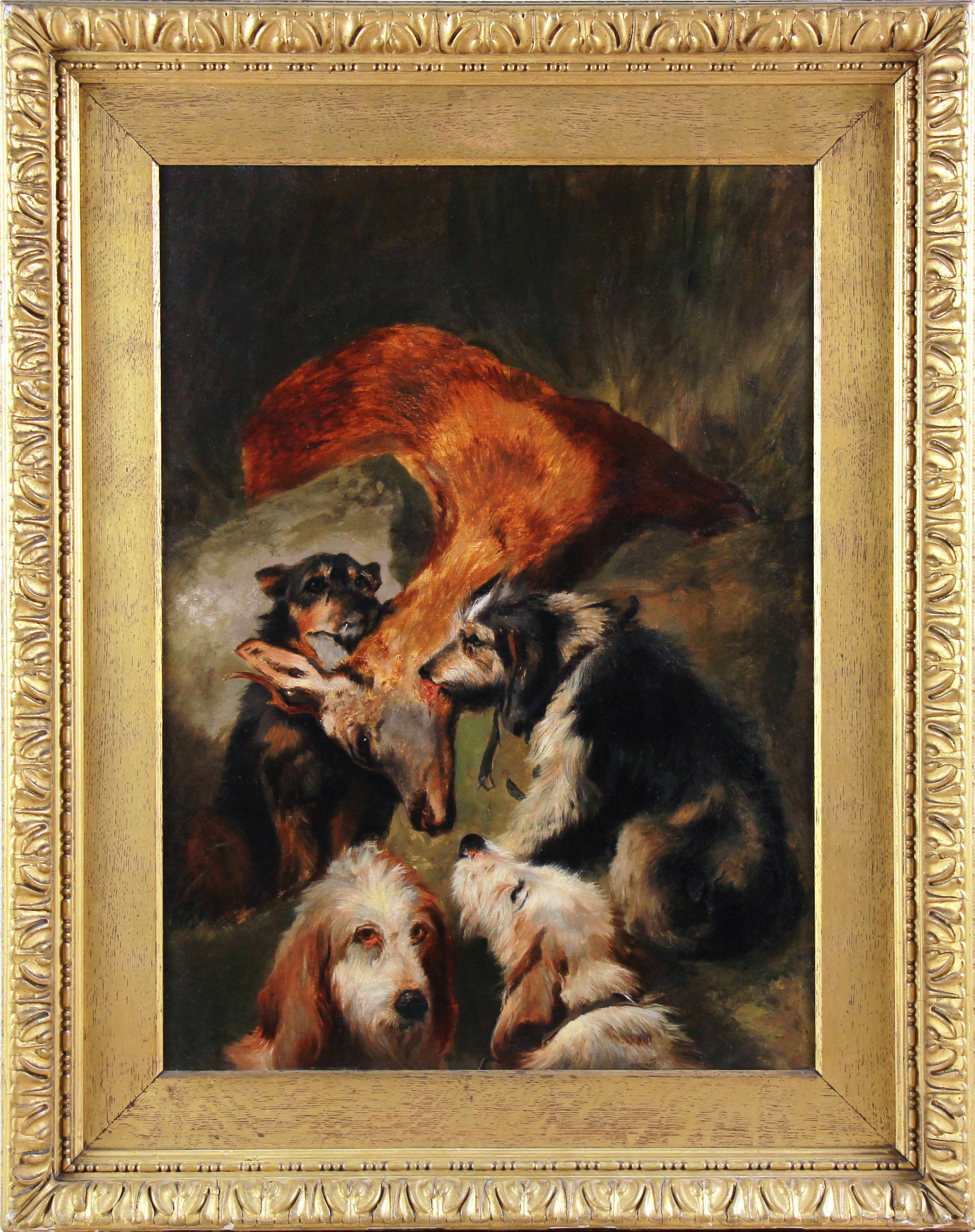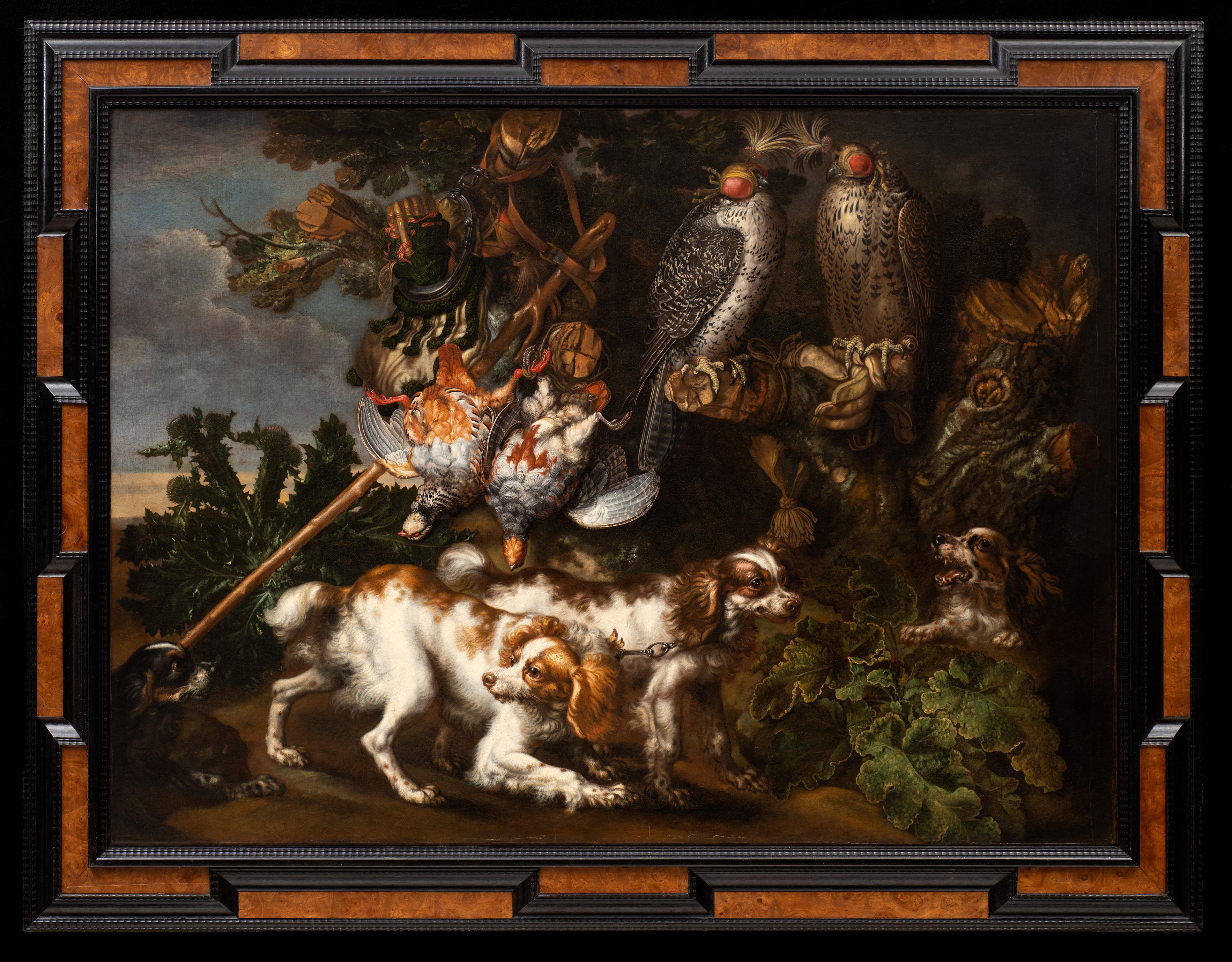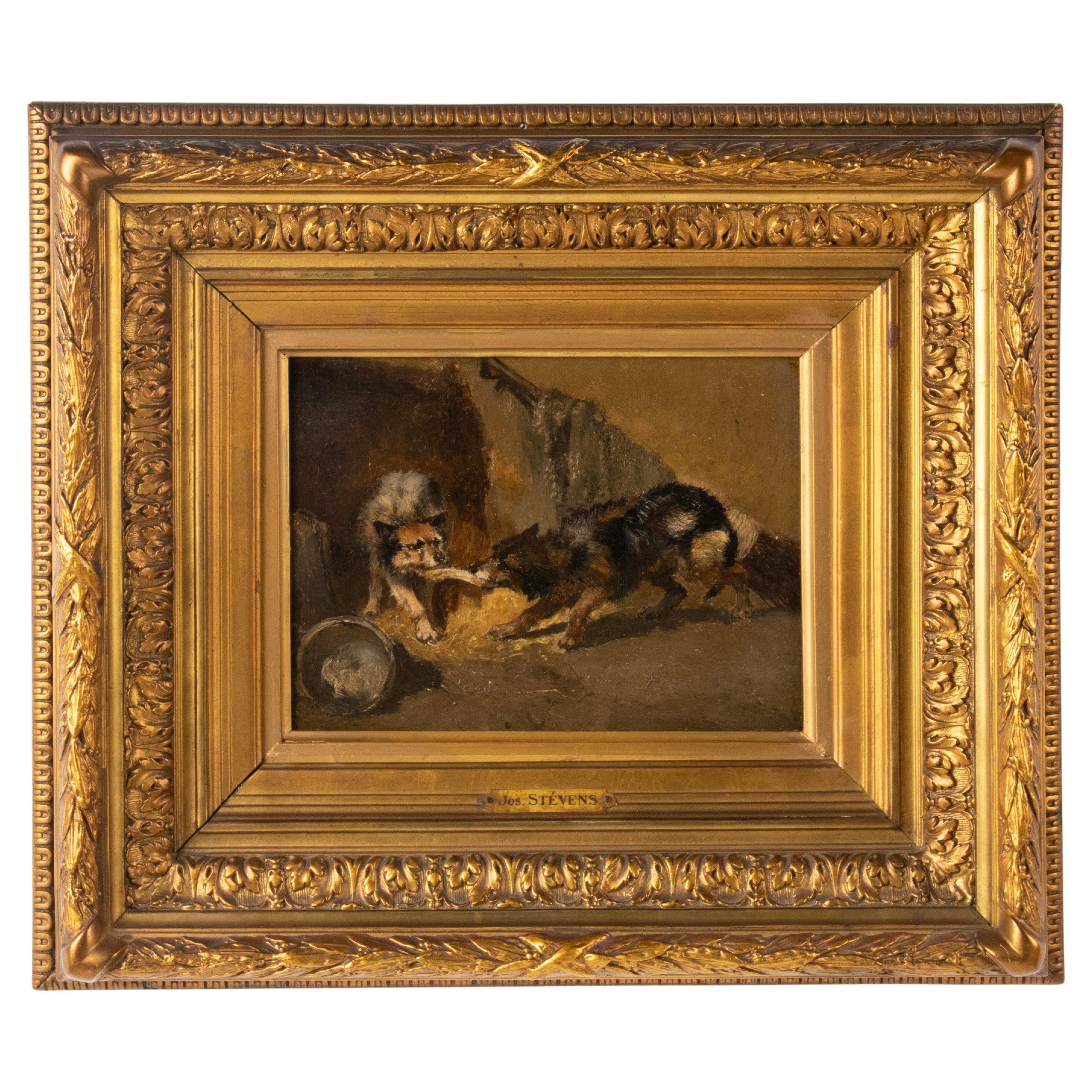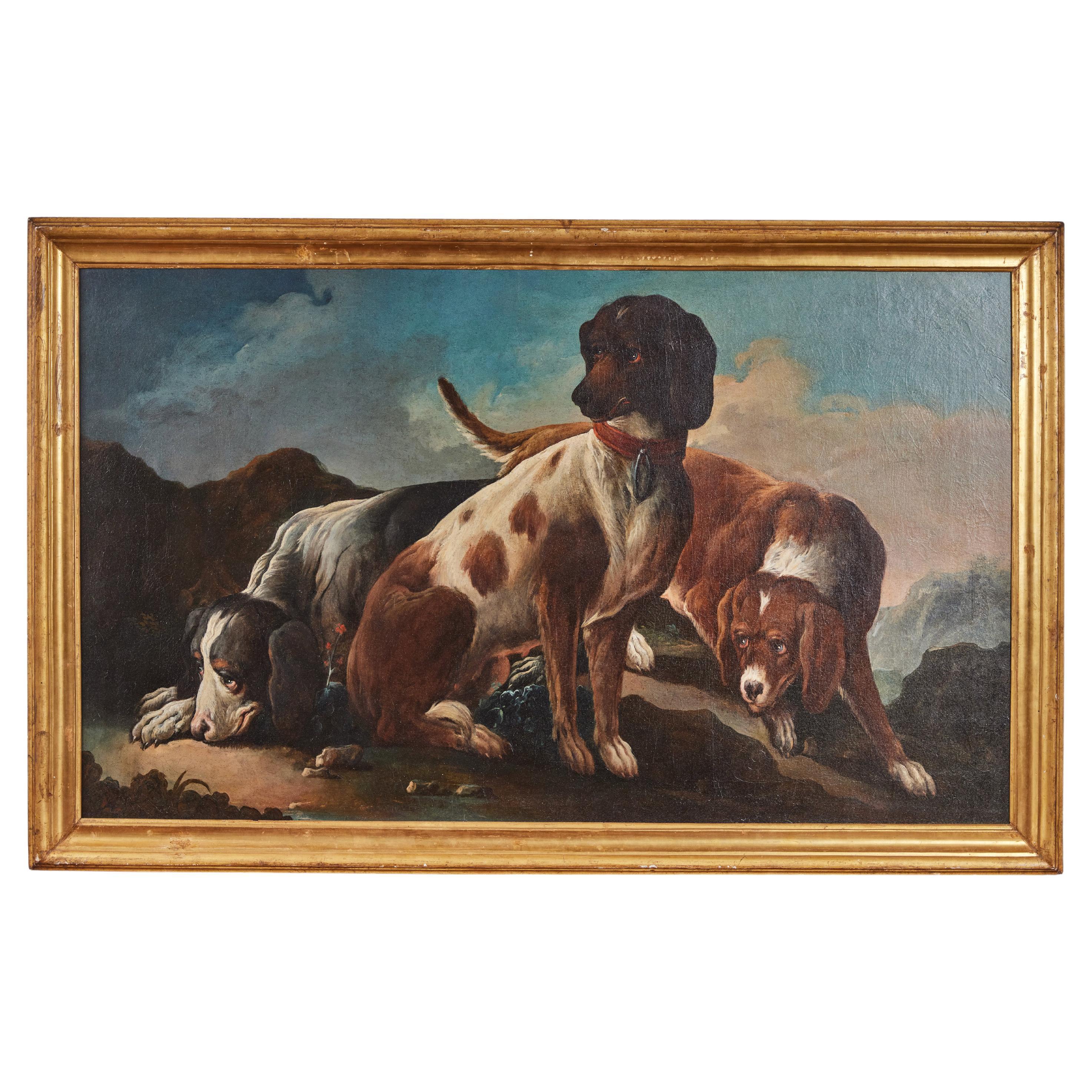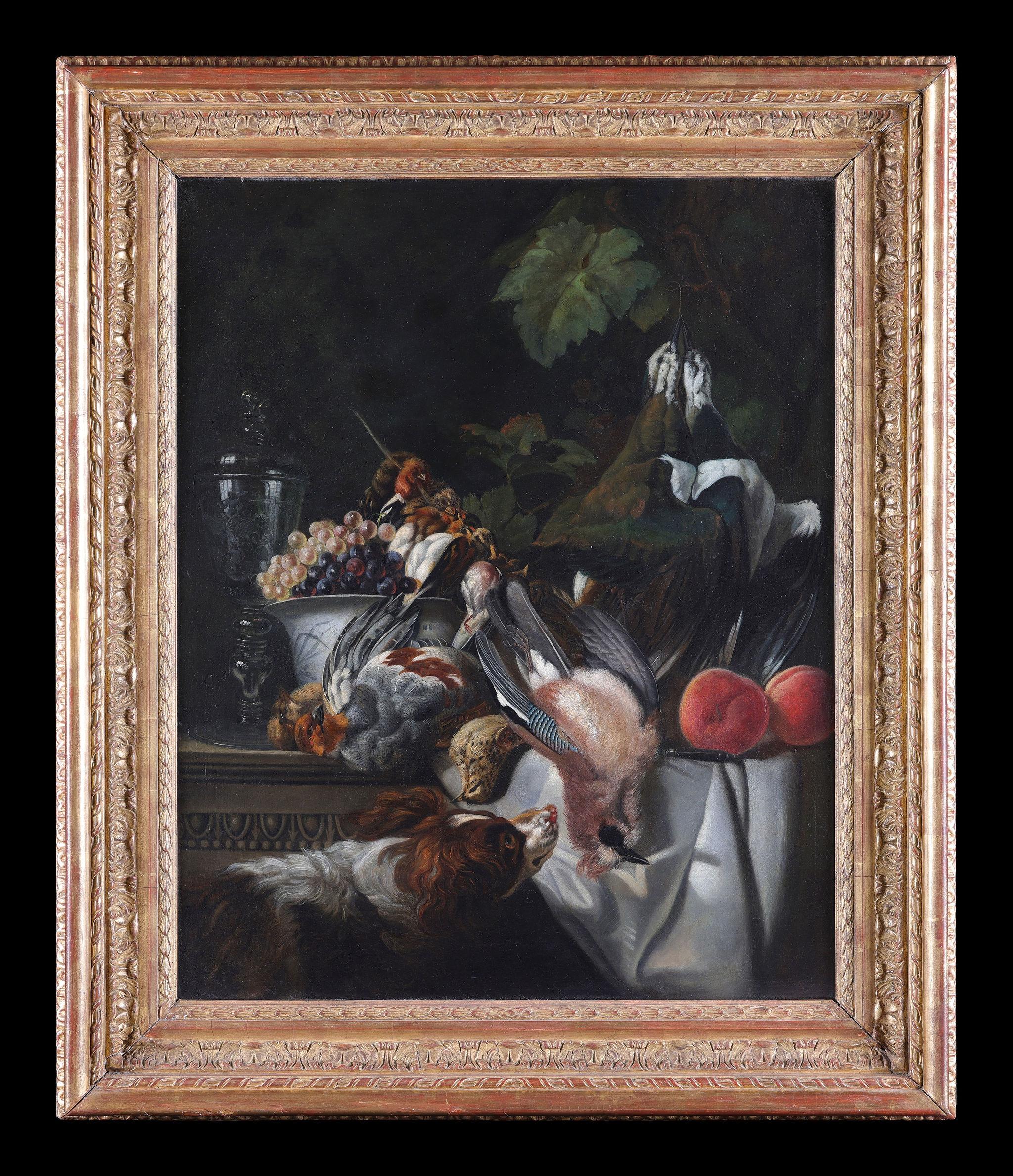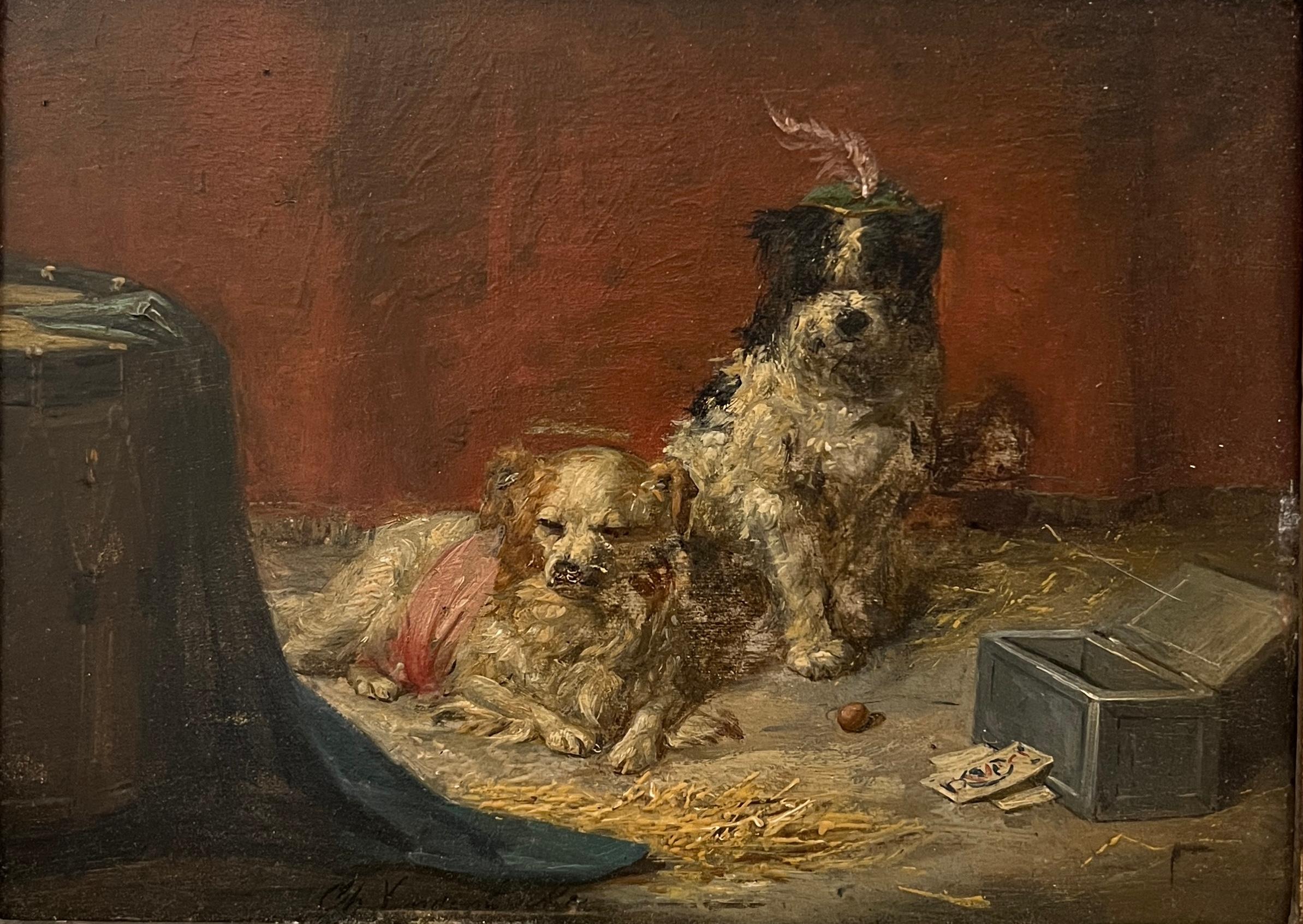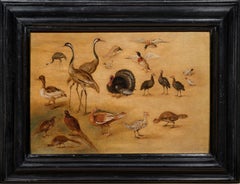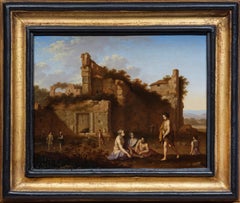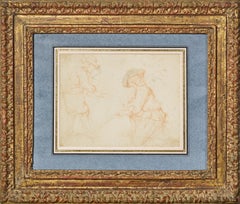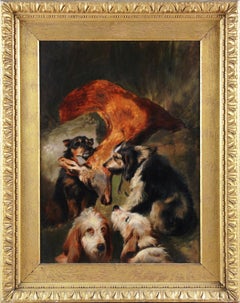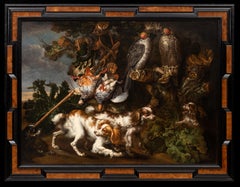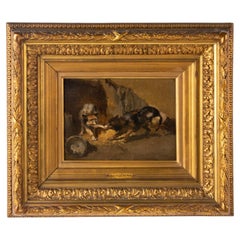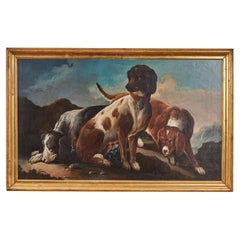Items Similar to Ten Dog Studies and a Study of a Stole, a panel attributed to Jan Weenix
Want more images or videos?
Request additional images or videos from the seller
1 of 14
Ten Dog Studies and a Study of a Stole, a panel attributed to Jan WeenixLate 17th century
Late 17th century
$23,077.94
£17,548
€19,500
CA$32,380.87
A$35,382.80
CHF 18,343.62
MX$422,697.75
NOK 233,433.69
SEK 218,549.27
DKK 148,522.73
About the Item
This painting, formerly attributed to Hyacinthe Rigaud, is typical of the art of Jan Weenix, one of the best still life and hunting painters of the Dutch Golden Age. In a cleverly disordered manner, he depicts ten studies of dogs (mainly spaniels and greyhounds) and the sumptuous study of a stole. These studies were probably intended to be used as a source of inspiration and adapted in the painter's compositions, as we will see in a close examination of some of his paintings.
1. Jan Weenix, a prolific still life painter
Jan Weenix was born into a family of artists: his father Jan Baptist Weenix (1621 - 1659) was also a landscape and still life painter and his mother Josyntgen d'Hondecoeter was the daughter of the animal painter Gillis d'Hondecoeter (1575 - 1638). His father trained him together with his cousin Melchior d'Hondecoeter (1636 - 1695).
In 1664 Jan Weenix became a member of the St. Luke's Guild in Utrecht, to which he belonged until 1668. In 1679 he married Pieternella Backer with whom he had 13 children. His compositions, often related to hunting (still lifes, portraits of hunters) were very successful, ensuring him a certain financial ease. Jan Weenix also painted large-scale decorations: while staying in Düsseldorf with the Prince-Elector of the Palatinate between 1702 and 1712, he executed twelve gigantic compositions combining landscapes, hunting scenes and still life for the Bensberg hunting lodge.
2. Description of the artwork
The painting displays a great apparent disorder that hides a rigorous organisation in four quarters. It presents ten studies of hunting dogs and one study of a stole.
The studies of the stole and of two of the dogs (the greyhound in the lower right and the spaniel in the upper right quarter) are quite elaborate, whereas those of the other dogs are sketchier. As an example, the dog in the upper right corner is only partially painted. The dogs' coats, of different colours - brown, sandy, grey or black - stand out against the warm brown background and are illuminated by the shine of their white hair.
This white colour, probably executed with ceruse white, illuminates the study of a stole which stands out in the lower left-hand corner while the red colour of its lining warms up the composition.
The purpose of this stole is enigmatic: we think it is probably a neckband, but it could also be the back of the turban of an oriental character. To the right of this stole is the outline of a long animal leg, perhaps a horse leg.
Similar studies are rare in the work of Jan Weenix, but the Rijksmuseum recently acquired the study of a seated monkey (8th photo in the gallery). This study, executed in the same brown chromatic range, is much more accomplished. It has been reused with minimal change in many compositions. It is likely that Jan Weenix had less frequently a monkey at his disposal, and that he therefore depicted it in great details, whereas he could probably easily find dogs as models. Note the characteristic white dot in the corner of each pupil that brings them to life!
3. Related artworks
We have tried to relate the various dogs in this study to the countless dogs that appear in the paintings of Jan Weenix, as listed in the catalogue 'Father and Son - Weenix' compiled by Anke van Wagenberg- Ter Hoeven in 2018.
A first example is the painting entitled "The Prodigal Son on the Steps of a Palace" (9th photo in the gallery). In the lower left-hand corner of the composition, a spaniel is barking at a peacock perched on a stone. This spaniel, which is depicted in a similar manner in the "Portrait of a Young Man with a Falcon" in the Bremen Kunsthalle, is reminiscent of the spaniel in the upper left-hand quarter of our study (although the latter is slenderer and the direction of its head differs).
We also find, in a slightly different pose, the seated greyhound that is at the top of our painting in the composition representing "A Swan, a Stag, a Hare and Birds presented by two hunting Valets" (detail in the last picture in the gallery). The sketch of this greyhound in our study is unfinished: the painter only painted the grey undercoat and the white parts of the coat, without completing the sandy coat which appears in the final painting.
We can see from these various examples that our study was probably more a repertoire of forms than a model for a specific composition. The painter probably used it for inspiration before adapting each dog study according to the specific needs of his compositions.
4. Framing
We have chosen to frame this painting in a Louis XIII period frame whose worn-out original gilding delicately enhances the shimmering whites of the painting and reinforces the contrast with the brown and orange chromatic variations of the composition.
Main bibliographic reference :
Anke van Wagenberg - Ter Hoeven - Father and Son - Weenix - Waanders Uitgevers, Zwolle 2018
- Attributed to:Jan Weenix (1642 - 1719, Dutch)
- Creation Year:Late 17th century
- Dimensions:Height: 13.38 in (33.99 cm)Width: 16.75 in (42.55 cm)
- Medium:
- Movement & Style:
- Period:Late 17th Century
- Condition:Size: 9 7/16’’x 12 13/16’’ (24 x 32.5 cm) – Framed : 13 3/8” x 16 ¾’’ (34 x 42.5 cm) Provenance: Alexis Gregory Collection (1936 - 2020), founder of Vendome Press Sotheby's New York - 22 January 2004 - lot 2016 (ca $14,300 including buyer's premium).
- Gallery Location:PARIS, FR
- Reference Number:1stDibs: LU1568217161472
About the Seller
5.0
Vetted Professional Seller
Every seller passes strict standards for authenticity and reliability
Established in 2020
1stDibs seller since 2021
10 sales on 1stDibs
Typical response time: <1 hour
- ShippingRetrieving quote...Shipping from: PARIS, France
- Return Policy
More From This Seller
View AllBird Study, a painting on panel by the Studio of Jan Brueghel the Younger
Located in PARIS, FR
We would like to thank Dr. Ursula Härting for confirming that this painting belongs to the studio of Jan Brueghel the Younger, by means of a certificate issued on December 12, 2024.
This rare study, executed directly with a brush on a prepared wood panel without any prior drawing, features some twenty birds, most of them domesticated. It is a fascinating testimony to the transmission of forms created by Jan Brueghel the Elder...
Category
1620s Old Masters Animal Paintings
Materials
Oak, Oil
Stag Hunting in the Vicinity of Nuremberg by a German Artist Peter von Bemmel
Located in PARIS, FR
This small landscape shows a hunting scene: two riders are chasing a stag with their dogs at the edge of a forest. Signed by Peter von Bemmel, it is typical of the production of this...
Category
1720s Old Masters Landscape Paintings
Materials
Copper
Gathering in antique Ruins, a monogrammed painting by Jan van Haensbergen
By Jan Van Haensbergen
Located in PARIS, FR
Jan van Haensbergen was a painter of the Dutch Golden Age and a pupil of Cornelius van Poelenburgh (Utrecht 1594 - 1667). The painting we are presenting is inspired by Poelenburgh’s landscapes from his Italian sojourn. The dreamlike atmosphere of this Gathering in antique ruins appealed to us. Against a backdrop of antique ruins, three draped characters (perhaps bathers) are sitting in a circle, greeting a fourth character walking towards them.
Their tranquility contrasts with the bustle of the other characters in the background. They constitute a vivid illustration of otium, this leisure time that allows us to realize our full potential. With this Arcadian landscape, Jan van Haensbergen invites us in turn to leave the hustle and bustle of everyday life behind, to take a break, to enjoy the present moment chatting with close friends…
1. Jan van Haensbergen, a landscape and portrait painter of the Dutch Golden Age
Jan van Haensbergen was born in 1642 in Gorinchem, a town in southern Holland to the east of Rotterdam. He was a pupil of Cornelius van Poelenburgh, and began by painting landscapes inspired by those of his master, in an Italianate style. Between 1668 and 1669, he was registered at the Guild of Saint Luke in Utrecht.
In 1669, he moved to The Hague, where he joined the Confrérie Pictura, an artist society founded in 1656. His portraits, which became his main activity as a painter after settling in The Hague, were strongly influenced by Caspar Netscher (Prague or Heidelberg 1639 - The Hague 1684), whom he met in The Hague and whose son Constantijn became his son-in-law by marrying his daughter Magdalena.
In addition to his work as an artist, Van Haensbergen was also an art dealer, probably helped by his appointment as Dean of the Confrérie Pictura, where he also teached.
2. Description of the artwork and related paintings
This painting seems to us to be a kind of allegory of otium, that quiet bliss promised by Epicurus. It might even evoke an Epicurean proverb: "It is better to lie on the naked ground and be at ease, than to have a golden carriage and a rich table and be worried" .
Three draped young people - two men and a woman in the background - are seated in a circle, greeting a fourth figure walking towards them, hair disheveled and body draped in a towel as if drying off after a bath, indicating the need for prior purification to fully enjoy this rest. Their nonchalance contrasts with the bustle of the various characters in the background.
The composition is punctuated by successive diagonals, and opens onto a landscape on the right, with a succession of mountainous planes. This painting is typical of the Italianate works produced by Van Haensbergen in the 1660s under the influence of Cornelis van Poelenburgh...
Category
17th Century Old Masters Landscape Paintings
Materials
Oak, Oil
Study for a Hunting Scene, a red chalk sketch attributed to Karel du Jardin
Located in PARIS, FR
We would like to thank Carolina Trupiano Kowalczyk for suggesting this attribution to Karel du Jardin after direct examination of the artwork. Her study of the drawing (in Italian), ...
Category
1650s Old Masters Figurative Drawings and Watercolors
Materials
Chalk, Ink, Laid Paper
Diana and Actaeon, a Mannerist painting after Joseph Heintz the Elder
Located in PARIS, FR
This painting seduced us with its rich colors. Depicting Diana and her companions surprised by Actaeon, it was inspired by an engraving by Aegidius Sadeler II after a painting by Jos...
Category
17th Century Old Masters Nude Paintings
Materials
Oil, Wood Panel
Allegory of the Treaty of Angoulême, a drawing attributed to Donato Mascagni
Located in PARIS, FR
We would like to thank Mrs. Ursula Verena Fischer Pace for suggesting the attribution to Donato Arsenio Mascagni.
We were immediately seduced by the rich tonalities of this allegory...
Category
1620s Old Masters Figurative Drawings and Watercolors
Materials
Ink
You May Also Like
Hunting dogs and a deer, British oil painting Richard ANSDELL 19Th c
By Richard Ansdell
Located in Gavere, BE
Hunting dogs and a deer, British oil painting Richard ANSDELL 19Th c
Description
Title: End of the run
Materials: oil on canvas
Signature: not signed
Provenance: private collection...
Category
1780s Other Art Style Animal Paintings
Materials
Canvas, Oil
Still Life of Spaniels and Falcons in Landscape Setting by Carstian Luyckx
Located in SANTA FE, NM
Still Life of Game with Dogs and Spaniels in a Landscape Setting
Carstian Luyckx (Flemish, 1623 – c.1675)
Oil on canvas
Circa 1670
Unsigned
43 ½ x 59 1/8 in.; Frame 52 7/8 x 68 7/8...
Category
1660s Old Masters Animal Paintings
Materials
Canvas, Oil
Mid 19th Century Oil Painting Dogs by Joseph Stevens
By Joseph Stevens
Located in Casteren, Noord-Brabant
An oil painting of two rustic dogs fighting over a piece of food. It is painted on an oak panel. Signed top left. The signature is a bit faded, it's a monogram J.S. by Joseph Stevens. He often signed with a monogram. In a gilded frame frame with gesso moldings.
Dimensions frame: 41 x 47 cm
Dimensions painting: 17 x 23 cm.
Joseph Stevens is the older brother of the very well-known artist Alfred Stevens. In the book 'The Belgian Art Book' by J. de Geest, it is written that Joseph Stevens has given a new dimension to painting animals. Joseph Stevens is an early representative of realism and social art. While Eugene Verboeckhoven has royal dogs pose on a beautifully embroidered cushion, Joseph Stevens already has an eye for the dark side of animal existence: exploitation by man, who in turn is a victim of society. His first successful painting, Brussels in the morning, shows how miserable dogs and poor people suffer the same fate. In the Sandman, Stevens shows a joint effort of man and dog, in which the viewer cannot ignore the social conditions: exhausting labor at dawn in some suburb. The gray sky and monochromy of the suburb add to the sinister atmosphere. Joseph Stevens was one of the first artists to take the urban proletariat as his subject. Stevens enjoys a very high reputation in his Parisian years. His brother Alfred writes: 'I am of this time, but you, Joseph, you are of the race, and thus you are of all times.' French critics agree. Stevens' works are a source of inspiration for the literature of the time. For example, Beaudelaire writes a poem about Stevens' dogs.
Joseph Edouard STEVENS. Belgium, 1819-1892
Stevens was a painter, etcher and engraver. Brother of the gifted painter Afred Stevens. Education at the Academy in Brussels (1834-1835). Debuted at the Salon in Brussels in 1842. Continued his career in Paris in 1852. He was primarily the painter of canvases depicting domestic animals (dogs, monkeys, horses), sometimes in curious, even idiosyncratic situations, and far from romanticism. This realism, of which he was one of the pioneers, earned him the interest of critics and intellectuals.
His approach was defined by this contemporary realism that eschewed idealized depictions of animals as heroic emblems of nobility. Rather, Stevens emphasized the ordinary animals of everyday life, with a particular focus on working dogs, stray dogs and all of the mutts that wandered the streets of Brussels. Museums and public collections, including' Royal Museum of Fine Arts Brussels, Ghent, Hamburg, Paris, Musée du Louvre, Rouen, Musee des Beaux-Arts. Stuttgart, State Gallery. King Leopold...
Category
Antique 1850s Belgian Beaux Arts Paintings
Materials
Gesso, Oak, Pine, Paint
18th Century Canine Painting
Located in Los Angeles, CA
Striking, beautifully composed, c. 1740, Italian, oil-on-canvas painting of three hounds in a mountainous landscape. Soulful, slightly naive and richly detailed. Held in an antique, ...
Category
1740s Paintings
Materials
Oil, Canvas
A Dog with Dead Game
By Jan Weenix
Located in St. Albans, GB
Jan Weenix
Canvas Size: 32 x 26" (82 x 66cm)
Outside Frame Size: 40 x 34" (102 x 86cm)
This beautiful painting is unsigned but this is not unusual with Jan ...
Category
Mid-18th Century Dutch School Animal Paintings
Materials
Oil
Two pet dogs
Located in Genève, GE
Work on wood
Golden wooden frame
24 x 30.5 x 3 cm
This striking work represents two dogs in an interior of warm, enveloping hues. The deep red background gives a rich and theatric...
Category
19th Century Animal Paintings
Materials
Oil
